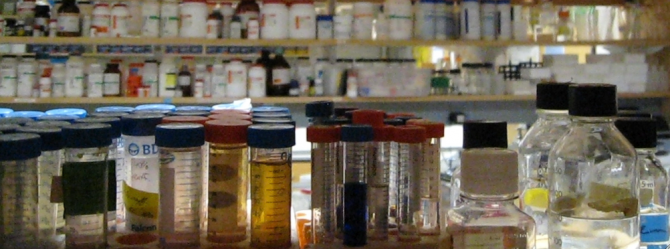20.109(S08):Data analysis (Day7)
From Course Wiki
Revision as of 20:34, 18 December 2007 by AgiStachowiak (Talk)
Introduction
Protocols
(Sequence only now after following both samples through all steps? Or sequence on 4 or 5 prior to induction or purification, respectively?)
(PAGE gel analysis as a FNT assignment, or also today?)
Part X: Titration curve
Today you will analyze the fluorescence data that you got last time. Begin by analyzing the wild-type protein as a check on your work, then move on to your mutant sample(s?).
- Open an Excel file for your data analysis. Begin by making a column of the free calcium concentrations present in your twelve test solutions. Assuming a 1:1 dilution of protein with calcium, the concentrations are: 0.1 nM, 1 nM, 10 nM, 100 nM, 250 nM, 500 nM, 750 nM, 1 μM, 10 μM, 50 μM, 100 μM, 1000 μM. Be sure to convert all concentrations to the same units. (WILL ALREADY HAVE DONE THIS CONVERSION ON DAY 3?)
- Now open the text file containing your raw data as an Excel file. Convert the row-wise data to column-wise data (using Paste Special → Transpose), and transfer each column to your analysis file. Add column headers to indicate which protein is which. Also include a column of your control samples that did not contain protein.
- Begin by calculating the average of your blank samples. Bold this number for easy reference. It is the background fluorescence present in the calcium solutions and should be quite low. Subtract this background value from each of your raw data values. It may help to have a 4-column series called “RAW”, and another called “SUBTRACTED.”
- To get a sense of your data, you can plot the subtracted data as is and have a quick look at it. Note the approximate inflection points of the curves. The inflection point is equal to the overall observed calcium affinity of IPC, or apparent KD.
- If your two replicate values for a different protein are wildly different, you may want to plot each curve separately. On the other hand, if your replicates are similar (as we expect), you will want to average them prior to plotting – this will improve the signal:noise of your dataset. When you do this, be sure to add error bars to your final plot.
- To get a more precise value of KD, you should normalize your data to resemble Figure 3 in the Nagai paper. The maximum and minimum fluorescence values for a given protein should be defined as 100% and 0% fluorescence, respectively, and every other fluorescence value should expressed as a percentage in between.
- Once you have analyzed the data you obtained from the fluorescence plate reader in this way, load your old Nanodrop data for the wild-type protein, and analyze it as above. How does the benchtop, single replicate assay compare to the plate reader data?
- Today or on your own time, prepare representative fluorescence curves for both your wild-type and mutant protein. These will be included in the data analysis portion of your portfolio.
